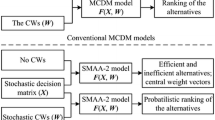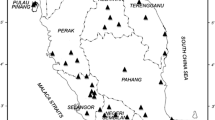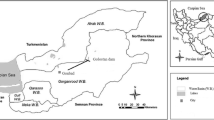Abstract
Several criteria should be considered when selecting a probability distribution to describe hydrological data. This study examines how multiple criteria can be combined to make the best selection. Selection becomes more difficult and subjective when more than two criteria are used to determine the best distribution. Under these conditions, multi-criteria decision-making is necessary. In this study, 12 distributions were tested and compared for flood frequency analysis based on five selection criteria: root mean square error, Kolmogorov-Smirnov test statistic, relative average bias, modified Anderson-Darling test, and deviation in skewness and kurtosis. The comparisons are made using a multi-criteria group decision-making (MCGDM) based on ordered weighted averaging (OWA). Two preemptive goal programming models based on variance and entropy methods for a predetermined level of optimism by a group of decision-makers, determined the weight of the OWA operator. The model was applied to a case study of Mahabad River, a major river flowing into Lake Urmia in northwestern Iran. A sensitivity analysis of the results of MCGDM was done by changing the degree of optimism of the decision-makers. The results of sensitivity analysis showed the dependence of the rankings to the optimism degrees of the decision-makers. The 3-parameter Weibull (WBL3) and Pearson type 3 (PE3) distributions had the best results for Mahabad River flood data. A Monte Carlo simulation was conducted to test the ability of the models. It was concluded from the findings of the simulation that the PE3 distribution is the most appropriate for short sample sizes, while WBL3 is preferable for larger sample sizes.






Similar content being viewed by others
References
Ben-Arieh D (2005) Sensitivity of multi-criteria decision making to linguistic quantifiers and aggregation means. Comput Ind Eng 48:289–309
Chiclana F, Herrera F, Herrera VE (1998) Integrating three representation models in fuzzy multipurpose decision making based on fuzzy preference relations. Fuzzy Sets Syst 97:33–48
Chow VT, Maidment DR, Mays LW (1988) Applied hydrology. McGraw-Hill, New York
Cunnane C (1989) Statistical distributions for flood frequency analysis. WMO No.718, WMP, Geneva
Duckstein L, Bobee B, Ashkar F (1991) A multiple criteria decision modeling approach to selection of estimation techniques for fitting extreme floods. Stoch Hydrol Hydraul 5:227–238
Fuller R, Majlender P (2003) On obtaining minimal variability OWA operator weights. Fuzzy Sets Syst 136:203–215
Haddad K, Rahman A (2010) Selection of the best fit flood frequency distribution and parameter estimation procedure: a case study for Tasmania in Australia. Stoch Environ Res Risk Assess. doi:10.1007/s00477-010-0412-1
Hajkowicz S, Collins K (2007) A review of multiple criteria analysis for water resource planning and management. Water Resour Manag 21:1553–1566
Hassanzadeh Y, Abdi A, Talatahari S, Sing VP (2010) Meta-Heuristic algorithms for hydrologic frequency analysis. Water Resour Manag 25:1855–1879
Hosking JRM (1994) The four-parameter Kappa distribution. IBM J Res Develop 38(3):251–258
Kahraman G, Birgun S, Yenen VZ (2008) Fuzzy multi-attribute scoring methods with applications. In: Kahraman G (Ed) Fuzzy multi-criteria decision making. Springer Science 187–208
Karmakar S, Simonovic SP (2009) Bivariate flood frequency analysis: Part 1. Determination of marginals by parametric and nonparametric techniques. J Flood Risk Manag 2(1):32–44 (13)
Kidson R, Richards KS (2005) Flood frequency analysis: assumptions and alternatives. Prog Phys Geogr 29(3):392–410
Kim KD, Heo JH (2002) Comparative study of flood quantiles estimation by nonparametric models. J Hydrol 260:176–193
Kuczera G (1982) Robust flood frequency models. Water Resour Res 18(2):315–324
Laio F (2004) Cramer-von Mises and Anderson-Darling goodness of fit tests for extreme value distribution with unknown parameters. Water Resour Res 40:W09308. doi:10.1029/2004WR003204
Laio F, Baldassarre GD, Montanari A (2009) Model selection techniques for the frequency analysis of hydrological extremes. Water Resour Res 45:W07416. doi:10.1029/2007WR006666
Liu X (2011) A review of the OWA determination methods: Classification and some extensions. In: Yager RR, Kacprzyk J, Beliakov G (Eds). Recent developments in the ordered weighted averaging operators: theory and practice. Springer 49–90
Mahdi S, Ashkar F (2004) Exploring generalized probability weighted moments, generalized moments and maximum likelihood estimating methods in two-parameter Weibull model. J Hydrol 285:62–75
Mashayekhi T (2001) Historical floods in Iran. Iranian National Committee on Large Dams (IRCOLD) In Persian
Öztekin T (2011) Estimation of the parameters of Wake by distribution by a numerical least squares method and applying it to the annual peak flows of Turkish Rivers. Water Resour Manag 25:1299–1313
Rahman AS, Rahman A, Zaman MA, Haddad K, Ahsan A, Imteaz M (2013) A study on selection of probability distributions for at-site flood frequency analysis in Australia. Nat Hazards. doi:10.1007/s11069-013-0755-y
Rai RK, Sarkar S, Singh VP (2009) Evaluation of the adequacy of statistical distribution functions for deriving unit hydrograph. Water Resour Manag 23:899–929
Rao AR, Hamed KH (2000) Flood frequency analysis. CRC, Boca Raton
Shabri A, Jemain AA (2006) Application of multi criteria method to identify the best fit statistical distribution. J Appl Sci 6(4):926–932
Shao Q, Wong H, Xia J, Ip WC (2004) Models for extremes using the extended three-parameter Burr XII system with application to flood frequency analysis. Hydrol Sci J 49(4):685–701
Shin H, Jung Y, Jeong C, Heo JH (2011) Assessment of modified Anderson-Darling test statistics for the generalized extreme value and generalized logistic distributions. Stoch Environ Res Risk Assess. doi:10.1007/s00477-011-0463-y
Song S, Singh VP (2010) Frequency analysis of droughts using the plackett copula and parameter estimation by genetic algorithm. Stoch Environ Res Risk Assess. doi:10.1007/s00477-010-0364-5
Tofallis C (2008) Selecting the best statistical distribution using multiple criteria. Comput Ind Eng 54:690–694
UNESCO (2003) Water for People, Water for Life. The United Nations World Water Development Report
Verma MK, Shrivastava RK, Tripathi RK (2010) Evaluation of min–max, weighted and preemptive goal programming techniques with reference to Mahanadi Reservoir project complex. Water Resour Manag 24:299–319
Wang YM, Parkan C (2007) A preemptive goal programming method for aggregating OWA operator weights in group decision making. Inf Sci 177:1867–1877
Wang Y, Richard CM, Ming JZ (2004) A multi-criterion evaluation approach to selection of the best statistical distribution. Comput Ind Eng 47:165–180
Yager RR (1988) On ordered weighted averaging aggregation operators in multi-criteria decision making. IEEE Trans Syst Man and Cybern 18:183–190
Yu FX, Naghavi B (1994) Estimating distribution parameters using optimization techniques. Hydrol Sci J 39(4):391–403
Zarghami M, Szidarovszky F (2008) Fuzzy quantifiers in sensitivity analysis of OWA operator. Comput Ind Eng 54:1006–1018
Zarghami M, Szidarovszky F (2011) Soft computing in water resources management by using OWA operator. In: Yager RR, Kacprzyk J, Beliakov G (Eds). Recent developments in the Ordered Weighted Averaging operators: theory and practice. Springer 269–279
Author information
Authors and Affiliations
Corresponding author
Rights and permissions
About this article
Cite this article
Mohammadpour, O., Hassanzadeh, Y., Khodadadi, A. et al. Selecting the Best Flood Flow Frequency Model Using Multi-Criteria Group Decision-Making. Water Resour Manage 28, 3957–3974 (2014). https://doi.org/10.1007/s11269-014-0720-1
Received:
Accepted:
Published:
Issue Date:
DOI: https://doi.org/10.1007/s11269-014-0720-1




